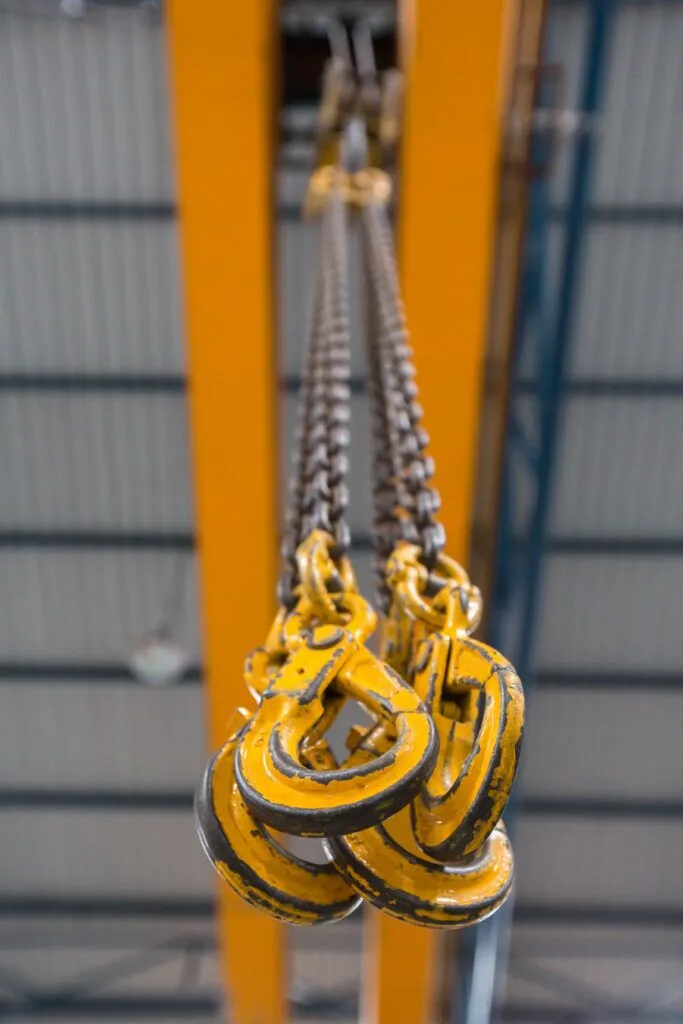Chain Sling Safety: Essential Tips and Guidelines
Chain Sling Safety: Essential Tips and Guidelines
Working with chain slings is a fundamental aspect of the rigging industry, involving the assembly and proper handling of these crucial tools for various loads and purposes. Given the significant role chain slings play in ensuring the safe and efficient transport of heavy objects, riggers must be well-versed in the use, maintenance, and handling of them. This expertise is vital to mitigating potential hazards that can arise on the job.
The Canadian Centre for Occupational Health and Safety (CCOHS) has established specific guidelines to ensure the safe use of all slings across various industries, particularly general industry, maritime, and construction. Adhering to these guidelines is essential for maintaining a safe working environment and preventing accidents.
In this blog, we delve into the importance of fully functional chain slings, how to use them safely, the steps for proper inspection, and what to avoid when handling slings.
The Crucial Role of Functional Slings
For manual workers, especially in the construction industry, the handling and relocation of materials and heavy objects are routine tasks. Without the right safety gear, these activities can lead to severe injuries. To prevent such incidents, it is imperative for site and project managers to use appropriate rigging equipment and mechanical gear, such as trucks, hoists, derricks, and cranes. Chain slings are integral components of this machinery, securing loads during transport.
Ensuring the safety and functionality of chain slings through regular inspections is critical to smooth operations. Proper sling safety not only protects workers from injuries like sprains and muscle tears but also safeguards against more severe, potentially life-threatening accidents.
Safe Usage of Chain Slings
Handling and maintaining chain slings require both education and focus. Inexperienced workers might struggle with using these tools correctly, potentially disrupting workflow and causing harm. For instance, using a complex 4-leg rigging chain without proper knowledge can be challenging and dangerous.
instance, using a complex 4-leg rigging chain without proper knowledge can be challenging and dangerous.
To use chain slings safely and effectively, consider the following tips:
- Proper Storage: Always store chain slings in a designated, dry place to prevent damage and wear.
- Correct Mode Factor: Apply the appropriate mode factor for the slinging arrangement to ensure stability and safety.
- Regular Inspections: Inspect chain slings and their accessories before each use and prior to storage.
- Careful Fitting: Fit slings carefully to avoid improper load distribution.
- Edge Protection: Protect slings from sharp edges to prevent cuts and abrasions.
- Hook Positioning: Ensure hooks are positioned outward from the load to maintain balance and security.
Conducting Thorough Sling Inspections
Chain slings should be inspected by a designated, knowledgeable person who follows the CCOHS sling inspection checklist. This checklist includes several detailed steps:
- Cleaning: Clean the sling thoroughly before inspection to identify any hidden damages.
- ID Tag Check: Ensure the ID tag is intact and legible.
- Leveling: Place the chain on a leveled floor or hang it until fully stretched to check for distortions.
- Untwisting: Untwist any twisted sections to assess the chain’s true condition.
- Measurement: Measure the length of the sling; remove it if it appears stretched.
- Component Checks: Inspect the master link, load pins, and hooks for signs of wear or damage.
- Documentation: Note the manufacturer, load limit, type, and previous inspection dates.
If the hooks are found to be open more than 15% of the standard throat opening or twisted more than 10° from the normal plane, they should be replaced immediately.
Practices to Avoid with Chain Slings
Maintaining chain slings in pristine condition requires adhering to best practices and avoiding harmful behaviors:
- Avoid Point Pressure: Never apply pressure on the point of the hook.
- No Impact Loading: Avoid jerking the load while lifted to prevent impact loading.
- Monitor Suspended Loads: Always keep an eye on suspended loads to ensure stability.
- No Dragging: Do not use chain slings to drag loads across the ground or floors.
- Discard Damaged Slings: Never use slings that are damaged or worn out.
- Avoid Forcing Hooks: Do not force hooks into place.
- Stay Clear of Suspended Loads: Never stand or pass under a suspended load.
- No Chemical Exposure: Do not apply chemicals to chain slings unless specified by the manufacturer.
Project and site managers must enforce strict policies against using damaged or defective slings. Even minimal wear and tear can compromise the safety of workers, making it crucial to replace slings showing any signs of damage.
Conclusion
Mastering the safe use and maintenance of slings is paramount in the rigging industry. By following CCOHS guidelines and implementing proper handling, storage, and inspection practices, workers can significantly reduce the risk of accidents and injuries. Safety should always be the top priority, ensuring a secure and efficient work environment.
For those seeking expert construction services, partnering with professionals who prioritize safety and adherence to regulations is essential. Their experience and dedication to following best practices in sling use and maintenance will contribute to the success and safety of any project.
Stay informed, stay safe, and ensure your rigging operations run smoothly by mastering the art of sling safety.
At Hercules SLR, we are proud to be a leading provider of top-quality safety gear and equipment. Trusted by countless professionals across the industry, we offer an extensive selection of lifting and rigging gear from renowned manufacturers. Whether you need equipment or training services to become an expert in your field, Hercules SLR is here for you.
Shop online at Hercules for your rigging essentials!
——————————————————————————————————————————————
The Hercules Group of Companies encompasses a wide portfolio of products and services across 7 diverse companies.


